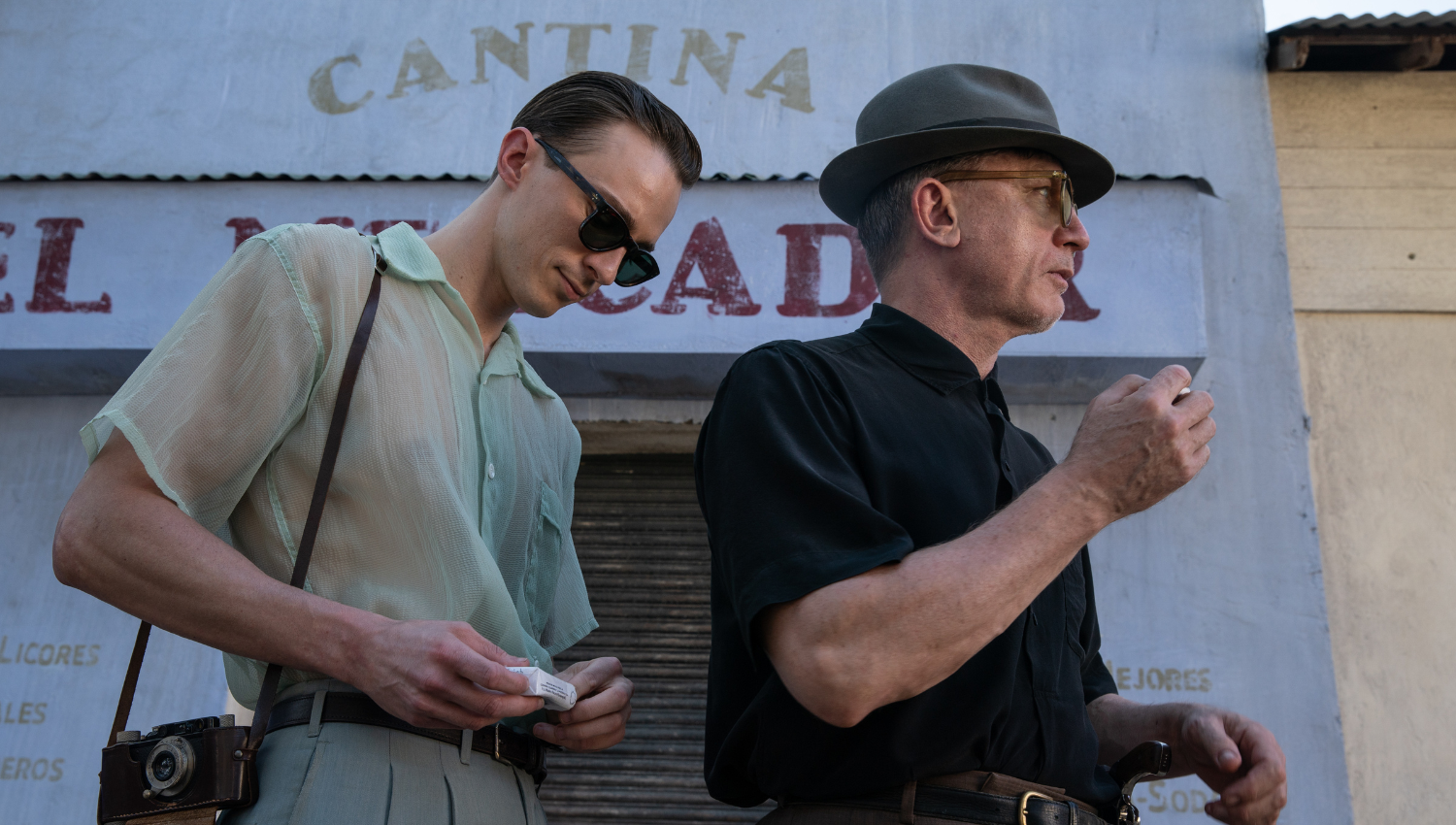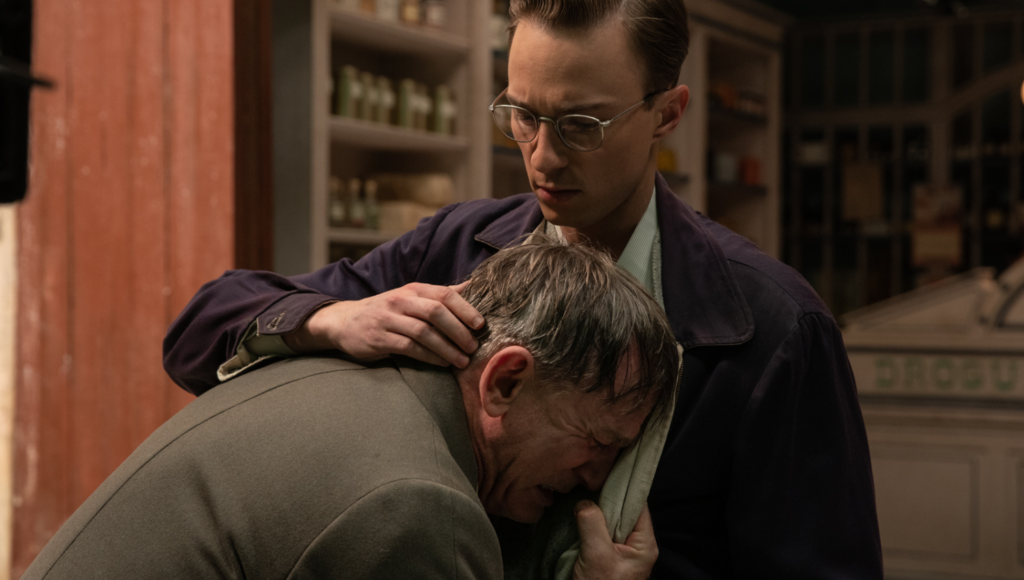
Queer
Mark White
Luca Guadagnino’s Queer dives into the semi-autobiographical material of William S. Burroughs’ novella of the same name by introducing us to William Lee (Daniel Craig) – a cacophonous man entering middle age, shamelessly flirty but riddled with his own self conscious. Lee spends his nights propping up one grubby bar counter after another in Mexico City, liquored up and leering at the lithe and lean bodies of young men and struggling to determine if they suffer the same ‘affliction’ and ‘proclivities’ that he does: William is queer, and his appetite remains unsatisfied. Haphazard and seedy trysts in grubby hotel rooms for a few hours are hollow, leaving Lee grappling with how to dull his desires and keep himself amused. Using ‘junk’ and steeping his days in tequila and flamboyant trash talk with his friend Ben (Jason Schwartzman), Lee lurches from one blurred evening to the next, up until he lays eyes on Eugene Allerton (Drew Starkey) – a decommissioned Navy man who possesses lean muscles on a tall frame, a knowing smirk and the potential air of…queerness? Lee makes it his obsessed mission to find out, flirting and following the new fellow in town until he can finally talk to him.
As Lee and Eugene get to know one another, personal boundaries fluctuate and blur; Lee wanting to give and take everything between them, Eugene giving in just enough let go of his inhibitions, but closing up and going cold the moment the sheets do. Drinks and meals and conversation has Lee reveal to Eugene that he has always struggled with his queerness and has found that he’s had to balance his ‘infirmity’ with the idea that everyone is a small part of a bigger meaning in life, and that he has a quiet hope that love might be that meaning. Lee also shares with Eugene he has heard tale of a plant growing in Central America that grants those who ingest it telepathic abilities. Lee hopes to be able to find the yage somewhere deep in the jungle and use that ability to truly connect with someone…someone like Eugene.
Upfront, it must be said: viewer beware. A Burroughs piece-turned-film will always bring psychedelic and surreal moments, the ugliest parts of someone, and a lot of metaphor that needs time and context to be fully understood. As it turns out, a Guadagnino adaptation of Burroughs is not only faithful (thanks to Challengers scribe Justin Kuritzkes), but as visually opulent and strange as what one may expect from the mind that wrote The Naked Lunch and the filmmaker that remade Suspiria. Drunken dream sequences with profound imagery abound here: abandoned babies, town locals in prison jumpsuits, writhing insects on body parts…and one incredibly wild sequence that not only informs the ending of the film but directly shares Burroughs’ guilt over the accidental murder of his common-law wife in a haunting reenactment of the infamous William Tell story involving poor aim. As the film builds to the third chapter and the search for Yage, the hallucinogenic finale of melding bodies and minds in a naked blur amongst a campfire and the stars is genuinely breathtaking – and bizarre – in the way that only Guadagnino can create.
Guadagnino steps back into overtly queer territory here, years after his widely celebrated Call Me By Your Name, but is tackling much more complex themes and characters in this Burroughs adaptation. Guadagnino presents Burroughs’ Lee as a subject with many vices and traumas that humanize him, but without sanitizing him. Lee is abrasive – almost acerbic – selfish, and incredibly vain, all of which Craig wears on his face with earnest abandon. Craig’s trademark steel-blue twinkle of the eye and knowing grin are nowhere near his James Bond here; gone is the suave and knowing killer, but a middle-aged man possessed of arousal, defiance, and a deep longing to be seen and loved – all seeping out of his tequila-soaked pores and every muscular movement. Craig peacocks, flaunts, bitches – equal parts awkwardly and deplorably at times – and it all works beautifully in portraying a man that is terribly insecure and desperate for affection and validation, aggressively hiding it with brittle bravado and harmful habits. Craig brings forth a man so unsure of his own worth, defined by the stigma of his true self – his queerness – that he actively pursues any distractions for it, no matter how dangerous.
In a strangely tangled juxtaposition, Drew Starkey’s Eugene is everything Lee wishes he was, however so superficially; Eugene is young, vibrant, virile – his masculinity so strong that his queerness is almost impossible to discern. Starkey’s tall frame, lean but chiseled, hardly ever opens up, nor does his face. Starkey’s good looks barely move – his Eugene is cold and enigmatic, rigid to the point of being brutally aloof. But his immaculate beauty – and what it represents to Lee – burns through the lens that Guadagnino and his longtime cinematographer Sayombhu Mukdeeprom frame him in, and Lee gets the full effect at every moment. The camera lingers and hovers over the sinews, the curves of Eugene, bringing the glacial setting between these two men to a smoldering anticipation…and then Eugene, one night, gives into..something. Nervous fumbling, joyous excitement, intoxicated abandon…all lead to sexual bliss between the two. A mutual, sensual experience…up until daybreak, and Eugene cannot dress fast enough and leave Lee’s home with little more than a nod and a wry smile. And so it goes: Eugene pulls away, then comes back to Lee in lusty companionship, only to retreat again and again.
A trippy, boozy, and devastating trip into a very gay ‘heart of darkness’ that shines a light on what it means to find acceptance from within.
Mukdeeprom’s camerawork is significant throughout the rest of the film; Mukdeeprom uses layered frames over Lee and Eugene through several sequences to allow Lee’s phantom presence to ‘touch’ Eugene without touching him at all – a visual metaphor for longing if ever there was one. At other times the camera watches Lee pantomime touching Eugene’s naked body or stroking his face, so close and yet so far – the aching longing heating the frame. Every sexual, sensual moment between these two men is captured and elevated with the camerawork just as much as the tension in their friendship.
Like the novella, Queer’s story is told separate from the events that occur in the novel Junkie, but the film and novella are also so heavily connected by the events preceding in Junkie – Lee’s childhood and his addiction background, his first homosexual experiences – that the story for Queer, as a film all on its own, lacks some critical context and details to make Lee fully realized. Having adapted the novella so literally, the scope of the film lives and dies by Lee’s character and not much else; thankfully, the camera and Craig are given time to allow flashes of emotion and layered change from one feeling to another that the gaps are mostly filled. One scene stands out most: Lee, falling into a need to cram ‘junk’ in his veins, heats a spoon and takes a hit. We know he feels isolated form Eugene. We’ve seen his invisible longing played out over Eugene’s body. We know he craves him more than the junk. But the desire – for Eugene, for love – is overwhelming, and cannot be satiated, so he must use junk to plug the hole. As the camera lingers on Craig’s Lee, eyes watering and slowly dragging on a cigarette, we are given several moments to see the thoughts on Lee’s mind dance across his eyes as the drug slowly takes hold of him. Lee is alone and ponders if will always be; he wants Eugene but cannot figure out if Eugene wants him…and he ponders if he can accept that he might not. It is a transfixing two minutes were the loneliness of one man gnaws at the heart of the viewer – queer or otherwise – and transcends the short story of its creator. Devastating, soul-searing stuff.

Perhaps the greatest failing of the film is that – in the same way that the story and script are limited to just the book its based on – Eugene is never rounded out enough counter some of what we get to see from Lee; Eugene is evidently struggling with his queer identity, but we are not allowed to see the struggle enough outside of how it effects Lee. And Lee’s infatuation is part of that to be sure; Lee sees him as an ideal and not a person. How can one find love like that? How can one find love without accepting themselves or others completely and unashamedly? All the junk and wild sex and pithy comments lambasting the queer life you are in does not lead to acceptance – it is denial plain and simple. Everything about Lee is denial personified, letting his queerness define him in ways that are not his own making.
The end result is a film that feels like a Burroughs fever dream, crafted by a filmmaker that is unafraid to look the complex emotions – and demons – of the author and wrestle with them. The studio lot sets add to the artificial way of life Lee has surrounded himself. There are anachronistic needle drops of musicians influenced by the Beat Generation that lend an unusual and self aware vibe to scenes where Lee seems blinded to his reality; hearing Joy Division and Nirvana warily wail about love and failed expectations is a genius touch for a story about two men trying to find themselves in one another in the seedy spots of Mexico City. But like all Guadagnino films, odd choices and shortcomings being what they are, the raw and tender heart of one man’s journey to find love – to find acceptance in himself – is what resonates. Guadagnino essentially offers us cinematic yage – not everything is spoken or detailed, the trip is not always comfortable, but it does communicate emotionally to its audience in a profound way, especially with an acting performance that settles in the bones. Not a perfect film, but a profoundly touching one.
Final Thought
Daniel Craig delivers a beautifully complex and intimate performance that will get people talking beyond the nudity - this is his finest work since Love Is The Devil. While not Guadagnino’s best film, it is a wonderful darker twin to Call Me By Your Name.
